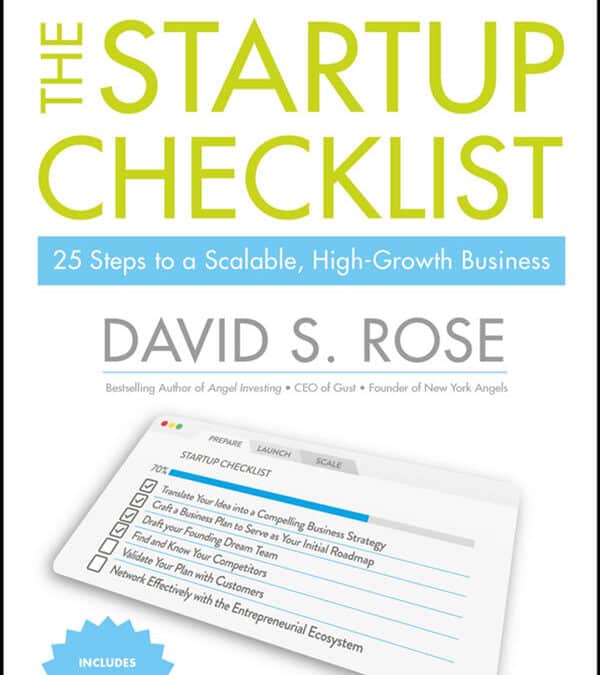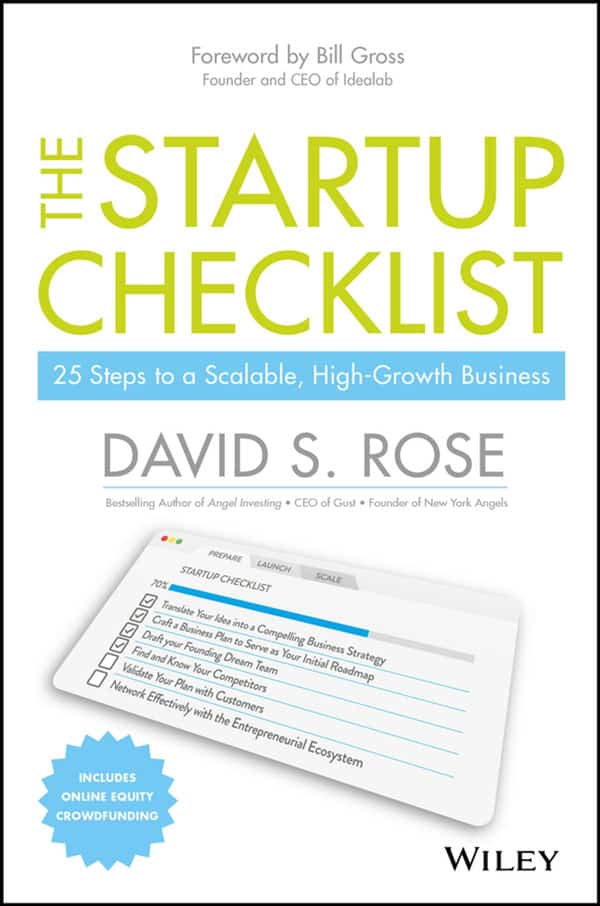The Startup Checklist, 25 Steps to a Scalable, High-Growth Business by David S. Rose
Recommendation
Entrepreneurs open thousands of start-up businesses, but only a few succeed. Serial entrepreneur and angel investor David S. Rose offers a thoughtful, comprehensive checklist to help you establish a start-up that will flourish. Using the format of 25 “key action steps,” he provides sage advice and insight to help you understand and tackle the challenges you will encounter along the way. Entrepreneurs would be well served to keep this manual close at hand and mull over it, not just read it once and put it aside. Rose discusses how difficult it is to find the right mentor, but getAbstract finds that his guidebook provides much of the insight a mentor might provide to anyone involved with planning, running or investing in a start-up.
Take-Aways
- Devise a great concept for your new business and “start smart” by following 25 “key action steps.”
- With today’s technology, you can set up your start-up infrastructure from your desk; you can emulate the frameworks of large companies for almost no cost.
- Determining a valuation for your start-up can be challenging.
- Potential investors will look at you more favorably if you have a professional, “comprehensive business plan.”
- Only one in 400 start-ups will obtain venture financing.
- Decide what measurements and data will best track the progress of your business.
- Establish an employee stock option plan to encourage talented staff members.
- Your odds of success increase if you can pool the skills, know-how, networks and assets of a group of qualified people, but hiring friends could threaten your relationships.
- Engage in regular, transparent communication with your investors.
- The more successful your business, the more likely your stakeholders will want to sell it.
The Startup Checklist Book Summary
Nitty-Gritty for Start-Ups
Entrepreneurs who are starting a business can choose among countless reference books, but they’re not all geared for 21st-century companies. A start-up firm generally intends to open strong, grow rapidly, hire employees, and – with success – find a larger company to acquire it or eventually go public.
“Every successful business, no matter how large or small, complex or simple, operates according to a business model that makes sense.”
To create and operate your new business profitably, heed 25 “key action steps” for “starting smart”:
- “A compelling business model” – Base your business on a great concept that you can convey in your business model. This creates a baseline to establish the benefits you’ll offer your customers. You must ascertain whether you can make a profit. First, ask if the profits you can generate selling a product or service exceed the cost of producing it? You want to give positive answers to these questions: Is the product right for a large pool of potential customers? Would customers buy it at a high price? Can you generate a large profit from the sale of individual units? Will the company’s viability increase as it grows?
- “A lean business plan” – Focus your business plan on generating value. Focus on lean efficiency and economy as you outline the actions you’ll take, set a schedule for these actions, and list your costs, responsibilities and desired outcomes. Your plan won’t remain static. You’ll revise it along the way based on the results of your actions as the business grows and changes.
- “Your competitors” – Understand your rivals and their strategies. Seek feedback from potential customers. Monitor your competitors’ promotional activities. Register for industry events to meet people who run other companies in your field. Visit your competitors’ businesses, and purchase their products. Interview your rivals’ former employees and customers. Gather as much data as you can about them, not just information that fits your preconceptions.
- “Your dream team” – Your chances of success increase if you can pool the skills, understanding, know-how, networks and assets of a group of qualified people rather than depending on yourself alone. Determine if you have the skills and willingness to play the role of an entrepreneur. Decide what kind of co-founder you need. Before you start, you and your team members should realize you could face failure or bankruptcy. If you hire friends, prepare yourself for events that could threaten your friendships.
- “Allocate the equity” – Discuss with your new colleagues how you will share equity. If you do it sensibly, you can help your business grow. If you don’t, you could destroy your venture. Value creation is a way of allocating equity. Think about the “entrepreneurial value” you and your colleagues are generating. Consider “replacement” costs: How much would it cost to hire someone to do a task that you’d otherwise do yourself?
- “A minimum viable product” – At some point, you have to turn your product or service into something to which your customers can react. Use the “Lean Methodology” approach, which calls for setting up a “build, measure” and “learn” loop. Create a prototype of your product or service. Show it to customers. Get their reactions, try new iterations and ask again. A few rounds of feedback should prepare you for a launch.
- “Establish your brand with online public profiles” – Begin building your brand early in the process of opening your business by using the immense resources of the Internet. Set up a website. Create public profiles at platforms like CrunchBase, LinkedIn and Glassdoor. If you seek investments from venture capitalists, create profiles on Gust and AngelList.
- “Network” – Life as a start-up entrepreneur can feel lonely. Seek support from a larger community that includes people managing other start-ups, those who finance them and people from government agencies that are interested in your company’s welfare. While these resources can’t ensure you’ll succeed, many successful entrepreneurs have drawn on such informative networks.
- “Incorporate” – You can do a number of things before you must set up a legally incorporated organization. However, if you continue to put structures in place without incorporating, you must accept total legal liability for everything your business does. Incorporate when you begin taking on partners, members of staff as well as investors, or by the time you need to set up a bank account. Benefits of incorporation include limiting your personal liability. You can also create shares to divvy up ownership of the organization.
- “Lawyer up” – Most entrepreneurs starting a new venture don’t think they need a lawyer, but you do. Lawyers know the regulations that govern starting an organization. Many start-ups try to save money in this area and regret it later. They often have to redo their initial work. In some cases, lack of incorporation might threaten your firm’s existence.
- “Recruit your boards of directors and advisers” – Once you incorporate your start-up, establish a board of directors. Legally, the board safeguards the interests of every shareholder. However, your board can do a lot more to help your business grow. Seek wealthy directors who are willing to invest in your business. Also look for people with specific, helpful skills. Seek directors who have the knowledge and insight to act as mentors to your company’s leaders. You may find several people who are willing to offer advice and counsel, but who don’t want to become directors. To take advantage of their insights, establish a board of advisers.
- “Select an accountant and accounting system” – Most start-ups fail because they run out of capital. To help prevent that pitfall, consult with an accountant. Ask him or her to set up a financial plan and a chart of accounts. Choose accounting software. Keep track of cash flowing in and out. Seek help with transforming your financial data into financial reports. Powerful “cloud-hosted” solutions are available at a relatively low cost.
- “Establish and manage your credit” – New entrepreneurs find it difficult to gain access to any money except their own. You have a slender chance of convincing suppliers to give you credit. They’ll want to review your credit history, which involves examining how often you obtained credit and then satisfactorily paid your debts. The higher your credit score – a figure that suggests creditworthiness – the easier it’ll be to obtain credit. To keep your business credit profile healthy, do many of the same things you’d do for your personal credit profile. Pay your bills on time, or risk reducing your credit score.
- “Open bank, credit card and merchant accounts” – Businesses require credit. Unfortunately, most bankers think it’s too risky to loan to a start-up. When your organization shows a history of revenue and profit, banks might finance some activities, like buying new equipment. Concentrate on dealing with one bank where the bankers will work with you and will evaluate your business prospects. Banks could want you to guarantee your business loan, which could imperil your personal assets if your start-up defaults.
- “Choosing your key technologies, platforms and vendors” – In the past, setting up the infrastructure for a rapidly growing company could require a great deal of effort and investment. With the rapid growth of technology, you can set up an infrastructure that emulates what the largest companies have – from your desk and for almost no cost. Since this works online across locations, collaborating with someone in another city is as easy as working with someone at the next desk.
- “Data analytics” – As your business succeeds, it will become progressively more difficult to gain insights into your processes. Depending on the nature of your business, decide what data and metrics you should monitor. Track only data you can evaluate for authenticity, act on and analyze.
- “Employees and freelancers” – As your start-up grows, you will hire more people. Lex Sisney, author of How to Think About Hiring, suggests signing up people who fit well with your business. Recruit candidates who help you amass an excellent team instead of hiring individuals who might not work well together. Place your current members of staff or people you intend to hire into one of four quadrants. “Team Leaders” fit well into their roles and have a high level of skills. They might be able to earn more elsewhere, but they choose to work with you. Do everything you can to hang onto them. “Team Players” may not have the same competence as team leaders, but they share your vision and don’t cost too much, relative to the market. Nurture them. “Specialists” have skills you need, even if they don’t share your vision. Use them sparingly. Don’t hire “Waivers,” people who might leave (or get fired) any time. They may lack skills and fail to share your vision.
- “Stock options” – Talented employees often migrate to start-ups for a chance to acquire equity in a company they believe will soar. If the company does well, the value of their shares could rise substantially. Set up a mechanism to provide equity to people you want to hire. Consult with a lawyer who understands start-ups. With your board’s approval, establish an employee stock option plan.
- “What investors want to see” – Businesses that start small or offer professional services need little initial capital. But most ventures require money to fund their growth. Since banks probably won’t lend to you, seek investors who will fund you in return for equity. Investors will examine the quality of your management team, the merit of your potential business opportunity, what makes your product or service unique, the industry you’re entering and how you will market your product. Potential investors expect you to have a thorough, thoughtful business plan.
- “Your investor pipeline” – Only 1 in 400 start-ups can obtain venture capital funding. Investors often think that you want money every time you talk to them. Be well prepared before you start your discussions because first impressions count. Become active in the start-up community. In order to reach out to possible funders, use networks like LinkedIn, submit pitches in entrepreneurial competitions and make presentations to angel investor groups.
- “Crowdfunding and online platforms” – President Barack Obama signed the “Jumpstart Our Business Startups Act – the JOBS Act of 2012.” Under Title I, companies can remain private and go public later, when they think it makes sense. Title II allows start-ups to advertise for funding, but it restricts the kinds of funders they can approach. Title III, which came into effect only in May 2016, allows start-ups to raise money from people who don’t qualify as “accredited investors” by working through “regulated online platforms.” Raising money under Title III means you must conform to stipulations that require extra work. Your accounting practices must meet generally accepted accounting principles, and you must file annual statements with the Securities and Exchange Commission (SEC).
- “Term-sheet negotiation and investor due diligence” – You’d be delighted if investors would give you money and get out of your hair. However, you’ll probably have to do more work to get your money. You must navigate legal documentation detailing how the different interests in the transaction relate to each other, and what rights and responsibilities each one has. These agreements can range from 3 to 120 pages. Your lawyers and your investors’ lawyers will draft these agreements. The legal package will include a term sheet that summarizes all the documents you’ll need to sign. While investors evaluate their funding plans, they’ll insist that you divulge important information as part of their due diligence screening of your business. They will double-check your assertions about the nature of your operations, including projections of profitability. They will also examine the legal structure of your business.
- “Your investors, now and in the future” – When investors put money in your business, you join a club of fortunate entrepreneurs. You gain a group of people who want you to succeed. It’s your responsibility to keep them abreast of developments in your business and to protect their money. Maintain rapport with your “lead investor,” and maintain regular, transparent communication with all your investors. Hold conference calls every six months to keep investors informed. Use them as a resource for sales referrals.
- “Your valuation” – Determining a valuation for your start-up is difficult but vitally important. Do it from the beginning when you’re fundraising from family and friends. As one of the founders, you want outside investors to pay a premium based on the potential future value of a share. Most investors prefer to pay a lower price in line with the share’s current value. How you treat your early investors could have a significant impact on your ability to raise money from other investors later. Don’t set too high a value since that could make it harder to win capital from venture funds and angel investors.
- “The benefits of success” – You may harbor the hope of cashing out one day in the future. You could build a large business, own it and live quite well. However, that becomes less possible if other people share a stake in your organization. In all probability, you’ll accept investments from venture capitalists and hire outstanding people. They all expect you to make money for them when you engineer a profitable sale of your firm. As a founder, you eventually can sell your venture to a big business, take it public or close it and lose everyone’s investment, but write off the money you and your investors paid.
About the Author

Founder and CEO of Gust, a platform for funding start-ups, David S. Rose established several businesses and serves as an angel investor.


